9
Implication Questions
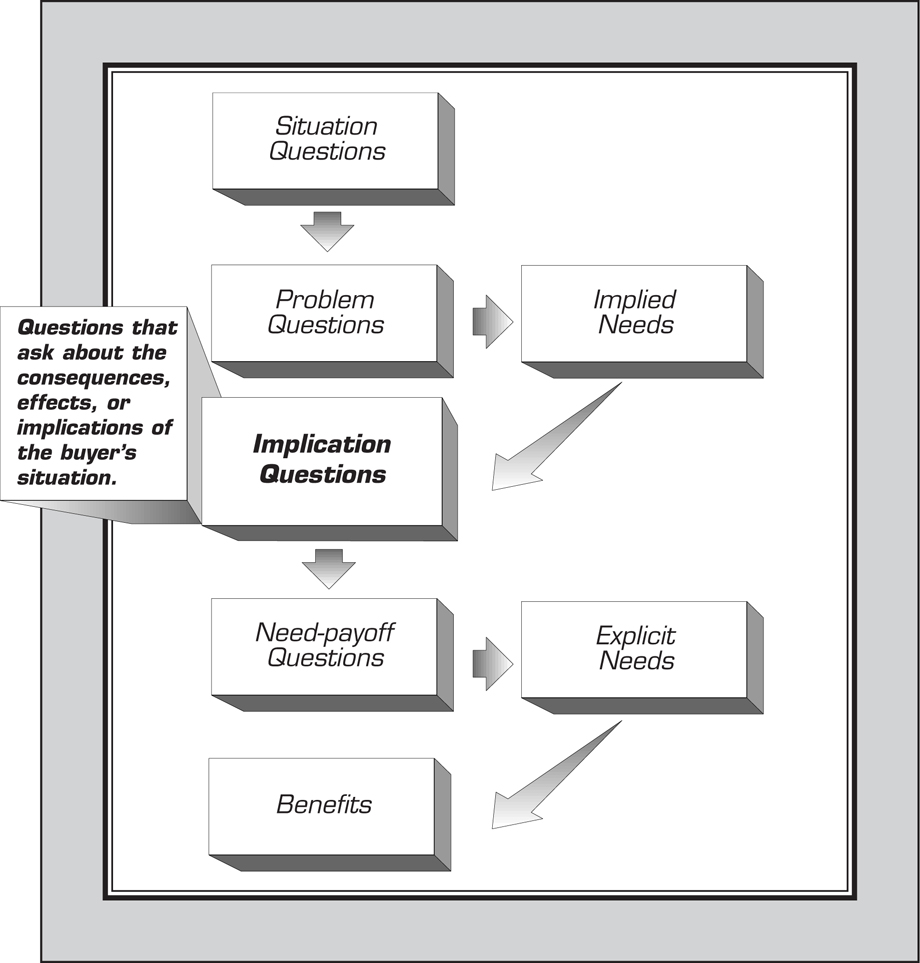
Overview
An Implication Question asks about the

![]() Consequences
Consequences
![]() Effects, or
Effects, or
![]() Implications
Implications
of the buyer’s situation.
They help you sell by building the seriousness of the buyer’s problem so that it becomes large enough to justify action.
Huthwaite’s research shows that Implication Questions are strongly related to success in larger sales. Their purpose is to develop the clarity and strength of a buyer’s problems by:

![]() Focusing on consequences of the problem.
Focusing on consequences of the problem.
![]() Extending and expanding the effects of the problem.
Extending and expanding the effects of the problem.
![]() Linking a problem to other potential problems.
Linking a problem to other potential problems.
Implication Questions are especially effective when selling to decision makers—people whose success depends on seeing beyond the immediate problem to underlying effects and possible consequences. Implication Questions help transform problems (Implied Needs) into Explicit Needs—the key buying signal in large sales.

![]() Implication Questions are a powerful needs development tool.
Implication Questions are a powerful needs development tool.
![]() They expand the buyer’s perception of value.
They expand the buyer’s perception of value.
![]() They’re harder to ask than Situation or Problem Questions.
They’re harder to ask than Situation or Problem Questions.

Could an increase in the value of the components result in a greater risk of theft?
How might that affect your insurance costs?
CHECK YOURSELF—IMPLICATION QUESTIONS
Before you learn more about using Implication Questions effectively, let’s be sure you’re clear about the difference between Implication and Problem Questions in the following list of examples.
Problem or
Implication
Question?
Answers are on the next page.
IMPLICATION QUESTIONS—ANSWERS
Using Implication Questions Effectively
If you missed a few of the previous answers, remember that Implication Questions are harder to prepare than Situation or Problem Questions. But while they are the most challenging of the SPIN® questions to use effectively, Implication Questions are also the most likely to lead to success in larger, more complex sales. Why? Because they are the key to developing problems from Implied Needs into Explicit Needs.
How do Implication Questions help the needs development process? In Chapter 6, you learned that the buyer’s problem has to be perceived as bigger than the cost of your solution before a decision to buy will be made.

You also learned that an Explicit Need has two components:
The function of Implication Questions is to develop the significance of the problem, so that it becomes clear and strong and the buyer sees it as worth solving.
What Goes into Good Implication Questions?
To ask good Implication Questions, you need:
![]() Planning—Implication Questions don’t just flow automatically from your mind. Even the most experienced sellers have to think about their Implication Questions ahead of the call.
Planning—Implication Questions don’t just flow automatically from your mind. Even the most experienced sellers have to think about their Implication Questions ahead of the call.
![]() Business knowledge—You’ve got to understand why a problem might be important to the buyer and what business issues might make it more significant than the buyer realizes.
Business knowledge—You’ve got to understand why a problem might be important to the buyer and what business issues might make it more significant than the buyer realizes.
![]() Application knowledge—You must know the kinds of problems your services or products are able to solve, so that you can select the most appropriate Implied Needs to develop.
Application knowledge—You must know the kinds of problems your services or products are able to solve, so that you can select the most appropriate Implied Needs to develop.
You Already Know How to Use Implication Questions
Implication Questions are the most challenging of the SPIN® questions used in complex sales, but you already use them in your daily life. Before you try planning for Implication Questions in a business case, it may be helpful to start with a more personal example.
Background
Your Task
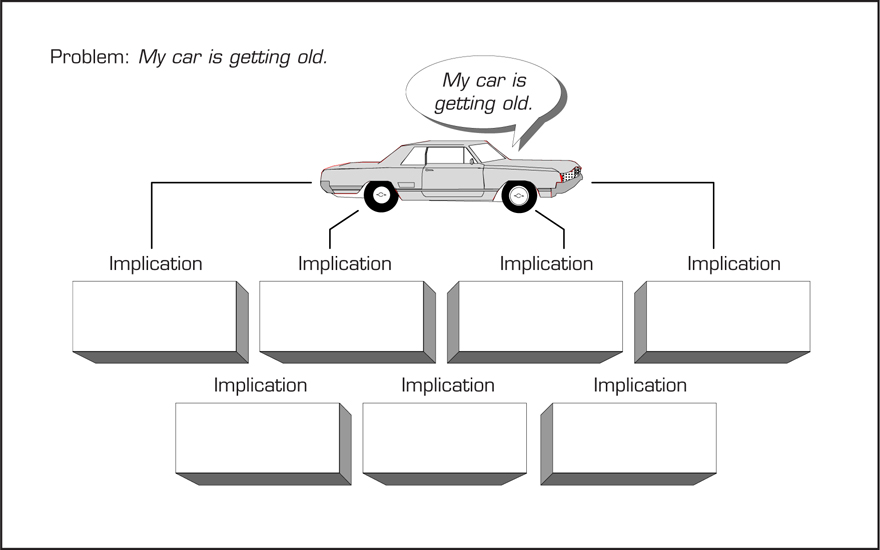
Develop the urgency of the problem by pointing out possible implications.
1. Read the Background Description on the previous page.
2. Once you understand the problem, see how many implications you can come up with.
3. Write each implication you come up with in one of the boxes provided above.
4. Draw arrows between the problem and implications, showing the directions you see between cause and effect.
5. Turn to the next page for possible results.
How Implication Questions Work
You might have raised any or all of the following implications:
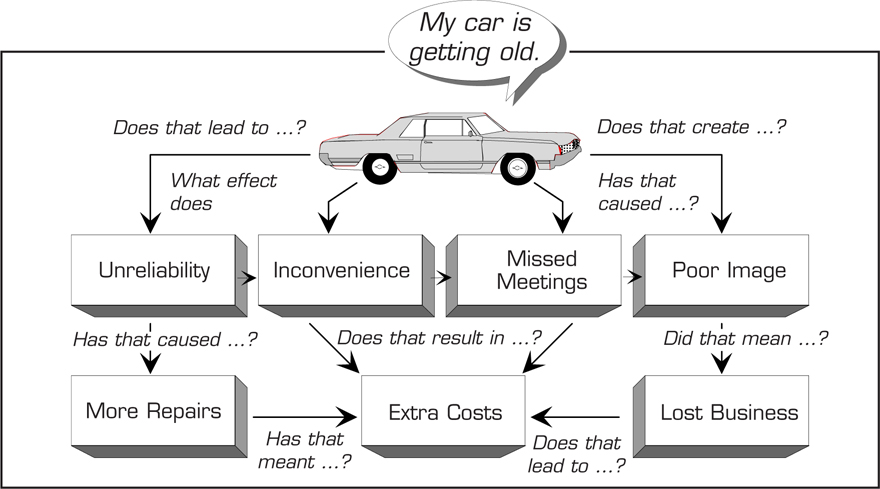
Implication Questions develop a small problem into a much bigger problem.
Did You Notice?
1. One implication often leads to another implication. In our example, reliability problems led to missed meetings, which hurt John’s professional image, which led to lost business.
2. Several implications can lead to one overriding problem or issue. This is often the case with cost issues. In our example:
![]() Repairs
Repairs
![]() Missed Meetings
Missed Meetings
![]() Poor Image
Poor Image
![]() Inconvenience
Inconvenience
![]() Lost Business
Lost Business
… all add up to extra costs.
3. Linking other possible problems or consequences to a given problem clearly increases its significance and urgency to the buyer.
Planning Implication Questions
It’s critical to plan Implication Questions in advance of a buyer call. Why? Since they don’t automatically come to mind, not planning could cause you to:
![]() Miss opportunities to ask appropriate Implication Questions when they might have the most impact.
Miss opportunities to ask appropriate Implication Questions when they might have the most impact.
![]() Cause you to fall back on inappropriate Situation Questions or Problem Questions and thus lose credibility.
Cause you to fall back on inappropriate Situation Questions or Problem Questions and thus lose credibility.
![]() Divert the buyer’s attention from problems you can solve to problems you can’t solve.
Divert the buyer’s attention from problems you can solve to problems you can’t solve.
Remember, the goal of Implication Questions is to build the significance of the problem so that it is clear and strong enough to lead a buyer to feel a strong want or desire for your service or product. So it’s important to be clear about the specific problems (or categories of problems if you provide services) the buyer has that you can solve, before planning your Implication Questions.
Four Steps for Planning Effective Implication Questions
Using a client or customer case of your own, try planning some Implication Questions. Don’t worry about getting the “right” implications as you practice steps 1–3. At this point, it’s more important to try to link each relevant problem with as many possible implications as you can.
1. Make sure you have asked all the Problem Questions necessary for you and the customer or client to uncover and clearly understand the relevant problems—those you can best solve for the buyer.
2. Select the key problems you’ve already identified that have or that are most likely to have implications you can develop into a need for your products or services.
3. Using the form on the next page:
![]() List the selected key buyer problems on the left.
List the selected key buyer problems on the left.
![]() List all possible related implications that you think might increase the significance of that problem to the buyer.
List all possible related implications that you think might increase the significance of that problem to the buyer.
4. Prepare some actual Implication Questions to ask the buyer. We’ll show you how to phrase effective Implication Questions after you do steps 1–3 on the next page.
How to Phrase Effective Implication Questions
It’s important for your Implication Questions to sound natural and relate appropriately to the buyer’s problems. There are three ways to do that:
1. Vary the Way You State Your Implication Questions
Many inexperienced SPIN® sellers get stuck when they’re first asking Implication Questions. They ask the buyer to come up with possible implications—by repeatedly asking just one type of general Implication Question such as, “What are the implications of that problem?”
To be effective, you need to help the buyer see the seriousness of the problem, by preparing some Implication Questions before your meeting and using a variety of phrases such as:

2. Use a Variety of Different Kinds of Questions
The SPIN® questions are not meant to be used in a rigid sequence. It’s appropriate sometimes to follow a Problem Question with a clarifying Situation Question, or an Implication Question with a Problem Question. The key is to ask questions in the sequence that best enables you to establish the context of, uncover, and develop the buyer’s problem.
3. Link Your Questions, as you learned to do with Situation Questions in Chapter 7.
![]() Link your questions to buyer statements.
Link your questions to buyer statements.
![]() Link your questions to personal observation.
Link your questions to personal observation.
![]() Link your questions to third-party situations.
Link your questions to third-party situations.
Now let’s look at another sales call that illustrates using these different methods to ask effective, natural Implication Questions.
Peter Roche, from Sound to Go, provides A/V services and equipment to conference centers. The buyer, Julie Crane, manages a conference center.
SELLER So you manage all the support operations in the conference center?
BUYER Yes. Besides managing our audio-visual services, I’m also responsible for housekeeping, catering services, office services, and the related personnel and administrative duties needed to keep our conferences running smoothly.
SELLER You said earlier that your conference schedule has been extremely busy for the past year. Has that caused any problems in the A/V area? [Problem Question linked to buyer’s statement]
BUYER It sure has. In the last three months, I’ve had to add a second shift of A/V technicians. Our equipment costs have also soared. [Implied Need]
SELLER During the tour, I noticed that you had a number of old VCRs and audio cassette players stacked in the corner of your equipment room. Does your A/V staff also do on-site equipment repair? [Situation Question linked to seller’s personal observation]
BUYER There’s usually regular downtime in our conference calendar for repairs. But there’s been no downtime for six months and Joe’s the only new guy who can fix the old equipment. So now, when we need it, there’s no extra equipment we can use. [Another Implied Need]
SELLER On the upcoming calendar you showed me, you’ll have three months of downtime before you get busy again. If Joe’s the only one on second shift doing repairs, how will the rest of the staff be productive during downtime? [Implication Question linked to seller’s personal observation]
BUYER That’ll be a problem. We’ve got to keep paying the second shift till we get busy again. Before, we used to just pay overtime to the first shift. That saved extra benefit expenses, but we lost good staff as a result. [Implied Needs]
SELLER Has your service quality suffered as a result of these staff problems? [Implication Question linked to buyer’s statement]
BUYER It really has. What I’d really like is a way to have qualified A/V staff on hand in the busy months, and be able to save on payroll and other overhead costs during the slow times. [Buyer has stated an Explicit Need seller can meet]
Implication Questions and the Complex Sale
In the complex sale you will usually be making a series of fact-gathering calls. Once you have a clear understanding of the organization and operation, you’ll have time in advance of the actual buyer discussion to pore over the problem areas you’ve uncovered and consider the potential linkages between them.
Planning ahead like this will help you to link issues in subsequent discussions with your buyer.
Knowing the issues thoroughly will also help you prepare a variety of Implication Questions. That way you’ll be prepared if additional consequences or related issues emerge during the buyer discussion that might require you to think on your feet.
When to Ask Implication Questions and When to Avoid Them
Ask Implication Questions after Problem Questions, but before introducing your solution.
One of the most frequent and dangerous mistakes a seller can make is to introduce a solution before the Explicit Need has been fully developed. When the customer agrees that a problem exists, it’s tempting to jump in with solutions. After all, the buyer’s got a problem and you’re there to provide answers. Don’t do it!
Instead, build a bridge to your solution first. Use Implication Questions that develop and extend the importance of the problem, so that when you do propose a solution, your buyer’s interest will be high.
Low-Risk Implication Questions
There are three low-risk areas where Implication Questions are especially valuable for developing and extending problems:
When problems are significant
When problems are unclear
When problems require redefinition
![]() When problems are significant. A buyer will readily tell you about issues like costs, wasted time, inconvenience, lost opportunities. Implication Questions also have high payoffs when the problem is complex or has a chain of ramifications.
When problems are significant. A buyer will readily tell you about issues like costs, wasted time, inconvenience, lost opportunities. Implication Questions also have high payoffs when the problem is complex or has a chain of ramifications.
Ben Franklin, who would have been a very effective seller, wrote a classic verse that illustrates how implications in a chain of ramifications can be used to develop and extend a problem.

![]() When problems are unclear. You can help bring them into sharper focus by asking Implication Questions. Helping your buyer think through tough problems can also strengthen trust and build a better working relationship.
When problems are unclear. You can help bring them into sharper focus by asking Implication Questions. Helping your buyer think through tough problems can also strengthen trust and build a better working relationship.
![]() When problems require definition. Sometimes it seems you can only offer a partial solution to the problem as it’s described. But if the buyer can be helped to think about it from another perspective, redefining the problem, your solution might fit better. An effective use of Implication Questions here can build the elements of the problems that your solution answers most strongly, increasing your chances of making a sale.
When problems require definition. Sometimes it seems you can only offer a partial solution to the problem as it’s described. But if the buyer can be helped to think about it from another perspective, redefining the problem, your solution might fit better. An effective use of Implication Questions here can build the elements of the problems that your solution answers most strongly, increasing your chances of making a sale.
High-Risk Implication Questions
The three occasions when Implication Questions should not be used or used with care are:
Too early in the call
With implications you can’t solve
In sensitive areas
![]() Too early in the call. It’s dangerous to ask Implication Questions before you have established a solid understanding of the buyer’s situation. Avoid creating mistrust or provoking buyer resistance by too abruptly probing for implications. It’s best to warm the call up with Situation Questions before asking about problems and implications.
Too early in the call. It’s dangerous to ask Implication Questions before you have established a solid understanding of the buyer’s situation. Avoid creating mistrust or provoking buyer resistance by too abruptly probing for implications. It’s best to warm the call up with Situation Questions before asking about problems and implications.
![]() With implications you can’t solve. Save your Implication Questions for building the significance of problems you can solve.
With implications you can’t solve. Save your Implication Questions for building the significance of problems you can solve.
![]() In sensitive areas. It’s always risky to delve into implications in sensitive areas such as organizational politics, personal issues, or decisions that the buyer has recently made.
In sensitive areas. It’s always risky to delve into implications in sensitive areas such as organizational politics, personal issues, or decisions that the buyer has recently made.
Practice Your Own Implication Questions
1. Select one of the implications you developed earlier in this chapter for one of your buyers.
2. List the implication you selected in the space provided below.
3. Prepare at least three variations of Implication Questions based on the single implication you selected, and list them in the spaces provided.
Example
Implication: The tight schedule means you could lose quality to beat the clock.
Implication Questions:
What impact could the tight schedule have on the quality of the bronchioscope?
Quality often suffers when you’re racing the clock. Do you feel that’s a risk here?
What are the down sides from such a tight schedule in terms of quality?
Can you talk about any risks you see of quality being affected by the tight schedule?
If you’ve only got three months, are you going to be able to keep quality the same?
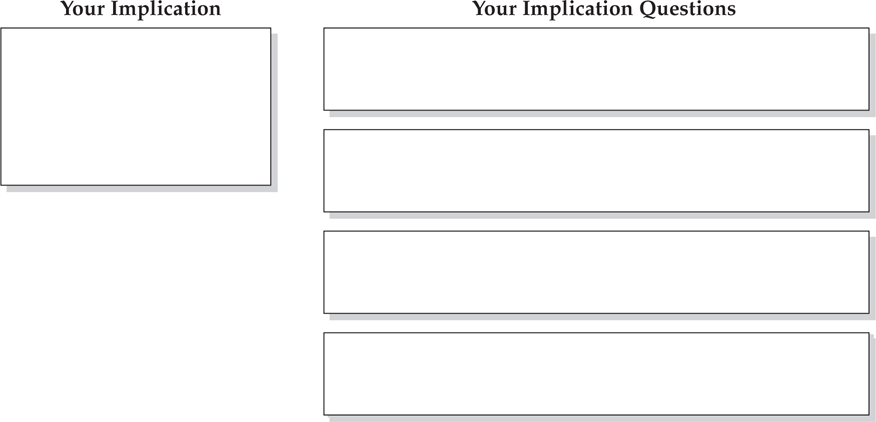
Beyond the Basics—Implication Questions
Problem Questions focus inside the problem, while Implication Questions focus outside the problem:

Ask Implication Questions as Much to Understand as to Persuade
Implication Questions increase pain by extending the seriousness of the problems. A fundamental principle of consulting, which applies equally to selling, is that good consulting keeps the client in moderate pain but never allows that pain to become excessive. Asking too many Implication Questions or working too hard to build pain can be counterproductive. Remember that your buyer can tolerate only a certain amount of discomfort. Don’t go beyond a reasonable level.
Inexperienced people, when first working with Implication Questions, feel they’ve succeeded only when they’ve increased their buyer’s pain level. Very successful sellers, however, will ask Implication Questions more to understand than to persuade. So if they ask, “What effect does this have on costs?” and the buyer says, “None. That doesn’t affect costs because we have so much spare capacity,” a good seller will be content. Experienced sellers find it’s just as important to learn that the implications don’t in fact exist where they anticipated them. This way they can focus on the areas that matter most to their buyers.
Implication Questions Can Link Various Departmental Problems into One Serious Company Problem
When you’re dealing with multiple buyers or a buying committee in a company, Implication Questions become a vital means of uncovering common ground for a shared sense of urgency around a multifaceted problem. Similarly, Implication Questions can link their internal problems with external customer problems that could translate into loss or potential loss of income for the entire company. When a small problem grows until it results in lost income, how can that company afford not to buy the solution?
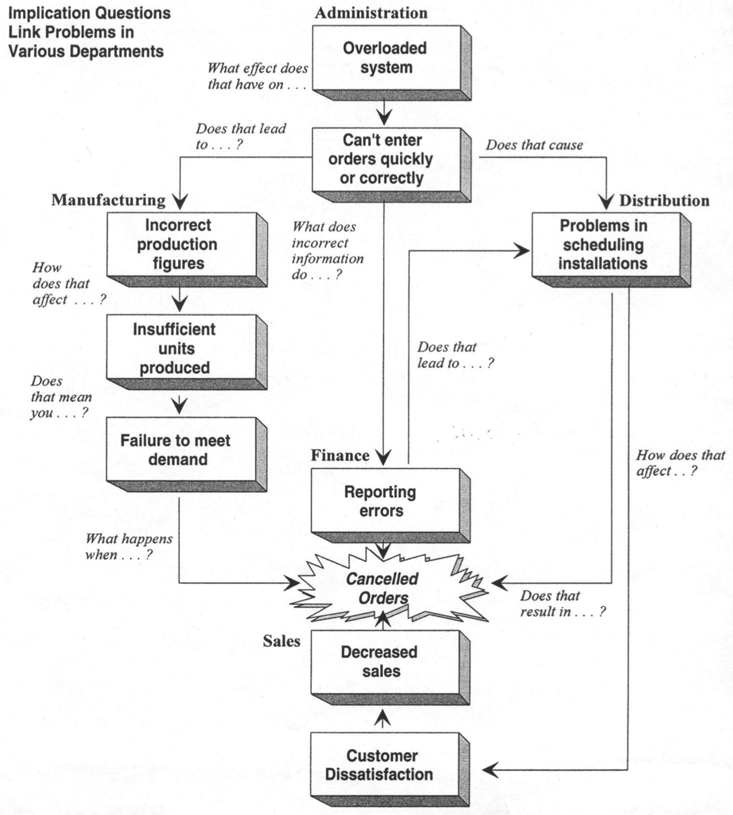
Implication Questions—Summary Check
Check your understanding of the use of Implication Questions by answering the following questions.
Answers are on the next page.
SUMMARY CHECK—ANSWERS
1. The purpose of Implication Questions is to develop Implied Needs so that they become Explicit Needs.
2. (a) and (c) are Implication Questions. In (a) the breakdown is the problem—production difficulties are a consequence (implication) of the problem. In (c), the inability to make the filings on time is the problem—delay in closing cases is a possible implication.
3. (b) and (c) are high-risk for asking Implication Questions.
4. (c) is correct. The time to ask Implication Questions is after a buyer describes the problem but before you introduce your solution.












